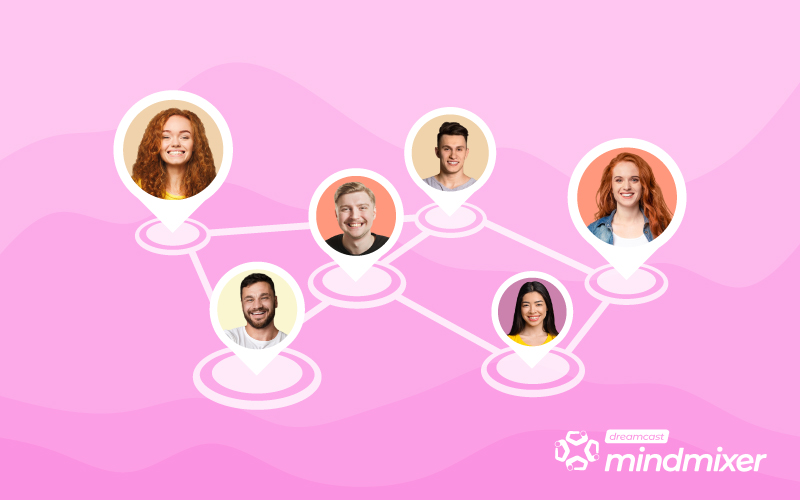In a sea of event matchmaking apps, how do you determine which one will truly make your event a success? Since networking is a major component of every event, the matchmaking tool used can either enhance or ruin the attendance experience. 52% of trade fairs, conferences, and B2B event organizers consider B2B matchmaking important to their success. But with so many options available, it’s essential to understand what sets the best apps apart from the rest.
Why Event Matchmaking App for Networking

1. Advanced Matchmaking Algorithms
Any great event-matchmaking tool is fundamentally based on an advanced algorithm meant to support excellent connections. These algorithms examine a broad spectrum of elements including professional backgrounds, interests, ambitions, and even behavioral tendencies, therefore transcending simple matching. These algorithms keep becoming better by using machine learning and artificial intelligence, providing more relevant and precise matches across time. For instance, the app can rank such matches depending on their profile and engagement record if an attendee wants to network with business executives.
The outcome is a more customized networking experience whereby attendees are more likely to encounter people who can offer insightful analysis, chances, or cooperation, thereby optimizing the general success of the event.
Read More: The Role of Matchmaking Apps in Driving Business Connections at Events

2. Easy Interface for Users
Encouragement of involvement and guarantee of maximum use of the matchmaking platform depends on a user-friendly design. This starts with a user-friendly onboarding system that walks them through minimal effort in setting up their preferences and profiles. The app should feature a clean design, clear navigation, and responsive elements that work seamlessly across various devices. For example, the search engine should let users, without much work, filter possible matches by particular parameters, such as industry or job position.
The app should also reduce the required clicks for important tasks like requesting a connection or planning a meeting. The software helps participants concentrate on what counts most: creating important relationships by lowering friction in the user experience.
3. Customizable Networking Options
Every event has different networking objectives, hence the best matchmaking applications offer customized choices to meet various needs. The event matchmaking app for networking should include several ways of contact, including one-on-one meetings, group conversations, and virtual meetups, regardless of the size of the industry convention or the specialized networking event. Event organizers should have the ability to tailor these options based on the event’s objectives. For example, a startup-focused event might prioritize investor-pitch meetings, while a professional conference might emphasize peer-to-peer networking sessions. Moreover, the app should let users customize their profiles and networking preferences so they may highlight particular abilities or interests fit for the theme of the event. This degree of adaptability guarantees that the software improves the networking experience instead of imposing a universal solution.
4. Communication Tools for Real-Time
Networking is based on good communication; it does not stop at merely pointing out a possible match. The best event matchmaking app for networking lets users communicate with their matches right away using a variety of real-time communication options like instant messaging, video calls, and live chat. These tools are essential for maintaining the pace since they let participants get from an initial connection to a deep discourse quickly. For example, during a session, an attendee might spot a possible partner and instantly start a video conversation to go over ideas more. These tools’ availability inside the app solves the need to migrate between other platforms, therefore simplifying the communication process. Real-time updates also guarantee that participants never miss a chance to interact, so the app is essential for active, mobile networking.
5. Reporting and Analytics
Measuring the success of the event and making informed decisions for the next ones depend on knowing how participants interact with the matchmaking app for event planners. Reliable analytics and reporting tools that give a thorough understanding of user behavior define the most useful applications. Trackers of data such as the number of connections made, the attractiveness of particular matches, participation levels, and even the success rate of planned meetings are organizers.
These findings can help matchmaking criteria be refined, user experience be enhanced, and the event’s layout be changed to more suit attendee needs. If data shows that attendees from a particular industry are highly engaged, organizers might choose to focus future events more heavily on that sector. By offering useful statistics, the app transforms into a potent tool for maximizing event results.
6. Excellent Privacy and Security Aspects
Yes, it is clear that data security and privacy are non-negotiable. Using a matchmaking tool requires attendees to believe their personal and professional data is safeguarded. Strong security measures such as end-to-end encryption, two-factor authentication, and strict data handling techniques are included in the best apps. Clear, open privacy protocols also reassure consumers that their information won’t be shared or used without permission. An app might, for instance, let users limit the quantity of information shared with others or regulate who may view their accounts. By giving security a top priority, the software not only protects user information but also fosters trust, therefore motivating more active and honest networking engagement.
7. Positive User Reviews and Testimonials
An event matchmaking app’s experiences of its customers frequently mirror its reputation. Good evaluations and quotes from earlier occurrences offer insightful analysis of the dependability and efficacy of the app. These evaluations might underline features including general satisfaction, customer service responsiveness, connection quality, and simplicity of use. Additionally, this input is very important for event planners in guiding their choice of app. In a competitive market, an app will probably stand out if it regularly gets compliments for its user-friendly layout and matchmaking accuracy. Furthermore, testimonies can provide actual cases of how the software has effectively enabled important connections, therefore strengthening credibility and confidence among possible users.
8. Seamless Integration with Other Event Management Tools
An event matchmaking app for networking should not exist alone but rather interact effortlessly with other tools for event management. This includes everything from registration platforms and event agendas to attendee directories and feedback systems. Such synergy makes the event experience more coherent and simplified. An attendee should be able to register for the event, change their matchmaking profile, and set up meetings (all inside the same environment). This lessens the need for several logins and lowers the possibility of data inconsistencies. Integration with CRM systems can also enable planners to monitor participant involvement and follow-up following the event. Working in conjunction with other technologies, the matchmaking app improves the general effectiveness of event management, therefore facilitating the achievement of goals by both organizers and attendees.
9. Ongoing Support and Updates
The digital landscape is always changing, as are the requirements of participants and organizers of events. One of the best matchmaking apps should provide constant updates and assistance if one wants to keep ahead. Regular updates guarantee that the platform remains compatible with the most recent technologies and platforms, and also bring new features and enhancements depending on user comments. For example, if users suggest that the app could benefit from better group networking options, a responsive provider might introduce this feature in a future update. Furthermore, strong customer service is necessary to handle any problems that develop throughout the event therefore ensuring a seamless experience for every consumer. Whether it’s through live chat, email, or phone support, having a dedicated team available to assist with technical issues or provide guidance can significantly enhance user satisfaction.
Constant development and quick support show the app provider’s dedication to producing a high-quality, dependable product that satisfies the needs of the event business.
Read More: Strategies for B2B Matchmaking: How to Thrive Business Connections
Final Words:
Selecting the correct event matchmaking app is about discovering a solution with more than just simple connection tools. It’s about choosing an app that meets your event’s particular demands, offers a great user experience, and shines in advanced matchmaking. By focusing on these key features, you can ensure that your event’s networking opportunities are not only effective but also memorable, making your event stand out in the crowded marketplace.
FAQs
An event matchmaking app is a digital tool designed to help event attendees connect based on shared interests, professional backgrounds, and networking goals.
A user-friendly interface makes it easy for attendees to navigate the app, set up profiles, browse potential matches, and schedule meetings. This ease of use encourages more active participation and ensures that users can quickly and efficiently make the most of the app’s features, leading to a better overall networking experience.
A standout event matchmaking app should offer customizable networking options to suit different event formats and goals. This can include one-on-one meetings, group discussions, virtual meetups, and even industry-specific networking sessions. The flexibility to tailor these options enhances the app’s utility for various event types.
A robust event matchmaking app should offer detailed analytics and reporting features, providing insights into user engagement, the number of connections made, meeting success rates, and more.






